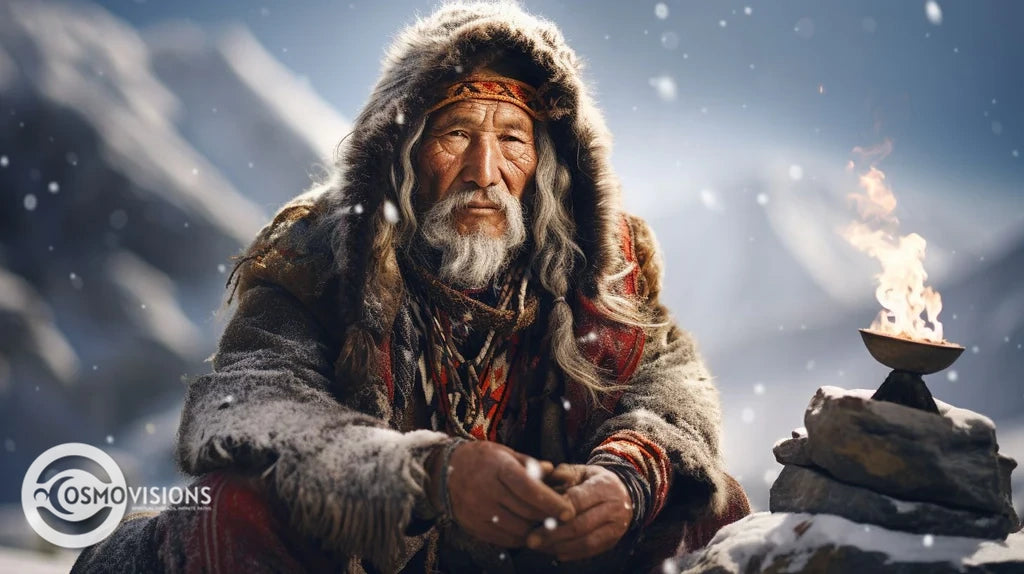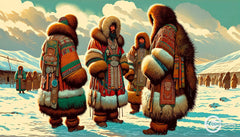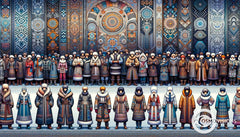Exploring Yakut Shamanism: Beliefs And Practices Of The Sakha People
Posted by Massimiliano Geraci

In search of spiritual depth and a connection to ancient wisdom, many find themselves drawn to the intriguing world of shamanism. The Sakha people of Siberia boast a rich tapestry of shamanic traditions that offer a window into this mystical realm.
Understanding these practices can be like unlocking the secret language of the earth's whispers—a quest for meaning in an increasingly disconnected world.
Here's a fact: Yakut Shamanism has survived centuries despite facing challenges from external influences like Christianity and political repression during Soviet times. Our exploration will peel back layers of time, shedding light on how shamans serve as bridges between humans and the unseen forces around us.
Key Takeaways
- Huichol Indians, or Wixárika people, live in the Sierra Madre Occidental range covering parts of Mexico and the US.
- They have a unique Uto-Aztecan language and their lifestyle heavily involves farming and hunting.
- Their religion is deeply tied to nature, featuring beliefs in spirits (Animism) with Peyote cactus playing an important role in religious practices.
- Vibrant artwork like yarn paintings and beaded crafts play a crucial part in Huichol culture, telling stories about their traditions.
- Challenges faced by the tribe today include maintaining religious freedom and dealing with environmental damages caused by modern development.
- Organizations are making efforts to preserve this indigenous culture amidst these ongoing challenges.
Discover the sacred rhythms guiding their rituals, and perhaps uncover truths that resonate with your own life journey.
Embark on this enlightening path through our article—you might just find what your spirit has been seeking. Explore further and let curiosity be your guide!

The Historical Roots of Yakut Shamanism
Yakut shamanism is steeped in ancient tradition, with its historical roots tracing back to the spiritual practices of Siberian peoples. This mystic heritage, interwoven with a wealth of folklore and legend, forms the foundation for the sacred rites and cosmological beliefs that have defined the cultural identity of the Sakha people through centuries.
Legendary progenitors and mythic origins
Sakha Republic's shamanistic origins are steeped in tales of ancient progenitors, tracing back to the legendary Omogoy Baai and Ellei Bootur. These figures loom large in Yakut folklore, embodying the spiritual genesis of the Sakha (Yakutia) people.
Passed down through generations, their stories resonate with powerful themes of connection to the land and cosmos. As mythical ancestors, they provide a sacred link between present-day worshippers and an age-old past.
Their narratives intertwine with Khoro Yakut beliefs where a venerable old man riding a bull named Uluu Khoro emerges as a central figure. This imagery captures more than just an origin story—it represents a cosmic lineage that defines the cultural psyche of Siberian peoples.
Moving from mythic foundations to core shamanistic tenets leads us naturally into exploring how these legendary beginnings inform current practices within Yakut culture—the subject of our next section: Core Beliefs of the Sakha People.
Core Beliefs of the Sakha People

The Sakha people hold a profound connection to the cosmos, where harmony with spirits and nature forms the essence of their existence, inviting readers to delve deeper into an intricate world view that has transcended generations.
The concept of Uluu Khoro and the cosmos
Yakut shamanism envisions a richly structured universe, where all life exists within three distinct but intertwined layers. This cosmos takes shape through the narrative of Uluu Khoro, an elder who traverses the realms on his bull.
His journey symbolizes the Sakha people's understanding of existence and their place within it. These layers, known as the upper world, middle world, and lower world, are not mere backdrops to Yakut life but are integral parts of their lived reality.
Shamans connect these cosmic spheres using rituals that honor Uluu Khoro’s ancient path. They believe that maintaining harmony between these worlds is essential for the health and prosperity of their community.
Engaging with these realms forms a core aspect of spiritual practice among the Sakha—bridging earthly experiences with celestial wisdom. Through this cosmological framework steeped in tradition, they navigate daily challenges while seeking guidance from supernatural forces that dwell within this complex system crafted by ancestral lore.
The role of nature and spirits in daily life
In the daily lives of the Sakha people, every tree, river, and stone is more than just a part of the landscape; they are living entities with spirits. These natural elements are deeply respected as they embody various deities and ancestral spirits that interact with humans.
The Sakha believe these spirit beings can influence their fortunes, health, and well-being. As such, rituals and offerings to honor them are commonplace to maintain harmony between nature and community.
This bond with nature extends beyond mere respect; it's viewed as a reciprocal relationship where care for the environment equates to spiritual balance for individuals. Their animist tradition holds that all things possess a spiritual essence which requires acknowledgment through ceremonies like blessings before hunting or gathering food from nature’s bounty.
Moving forward, understanding this intricate connection helps us appreciate the responsibilities shamans undertake in Yakut shamanism.
The Shamans of Yakutia
The Shamans of Yakutia serve as pivotal mediators between the human realm and the spirit world, wielding cultural knowledge that continues to captivate those intrigued by ancient wisdom.
Duties and significance of the Shaman
Shamans hold a key role in Yakut society, serving as intermediaries between the spiritual and physical realms. They carry out critical tasks including communing with spirits, guiding souls, and safeguarding the community's spiritual wellness.
Masters of ceremonies and rituals, shamans invoke supernatural powers to heal the sick by addressing imbalances in their three souls—a fundamental aspect of Sakha belief concerning health.
Their connection to benign entities is crucial; they negotiate for harmony between humans and these protective spirits.
Such spiritual leaders undergo rigorous training, signifying their importance and respect among the Sakha people. This depth of knowledge allows them to specialize in various healing methods that sustain traditions steeped in centuries-old wisdom.
Undertakers of sacred duties, shamans preside over funerals ensuring that each soul receives proper attention during burial practices. Their influence permeates daily life as well as solemn occasions—embodying an enduring reverence for shamanistic guidance within this northern culture.
The initiation and training of a Yakut Shaman
Becoming a Yakut Shaman is not a choice but a calling, stemming from ancestral selection. This profound journey starts with an initiation rite where the chosen individuals experience visions that transport them to otherworldly realms.
Here, they negotiate alliances with spirits and gain insight into the shamanic path ahead. The training process involves mastering divination techniques, learning sacred songs and dances, and understanding the healing properties of herbs and rituals.
Candidates endure rigorous spiritual discipline to harness their powers and serve as intermediaries between humans and supernatural beings. They learn to interpret dreams, communicate with animal spirits, and perform complex ceremonies designed to maintain harmony in the community.
Their guidance often leads people through life's pivotal moments - from birth to death – ensuring the well-being of both individuals and nature alike. After this section on training, we explore the diverse rituals that define Shamanic practice among the Sakha people.
Shamanic Practices Among the Sakha

Embark on a journey through the unique and intricate shamanic practices of the Sakha people, where age-old rituals intertwine with the spiritual fabric of their culture.
Rituals and ceremonies
Shamanic rituals and ceremonies stand as the heartbeat of Yakut culture, weaving a tapestry of spiritual practices that resonate with the natural world. During these events, shamans engage with spirits to ensure harmony between humans and nature.
The YHYAK festival showcases this profound connection through an array of vibrant activities such as horse races, feasting, wrestling, and line dancing that lasts until dawn. Attendees witness a blend of physical prowess and spiritual dedication in this significant summer celebration.
Wedding ceremonies among the Sakha people are steeped in tradition, honoring couples through sacred acts by memorial hitching posts. These rituals include offering prayers for the newlyweds' happiness, presenting special foods to symbolize prosperity, and partaking in dances that reflect their community's joy.
Each aspect encapsulates centuries-old customs passed down generations—a vivid testament to the resilience and importance of Yakut shamanistic traditions amidst modern changes.
Tools and symbols in shamanic rites
Shamanic rituals are rich with various tools and symbols deeply rooted in Sakha cosmology. Drumming is a key element, as shamans use their drums to enter trance states, traveling between the different layers of the cosmos.
Decorated with significant motifs, these drums represent the universe itself and serve as a vehicle for spiritual journeys. The shaman's costume also holds great meaning, often adorned with representations of spirits or animals that embody powerful forces of nature.
Ceremonial items such as staffs or wands are common in these rites; they symbolize authority and a connection to higher powers. Feathers and bones may be used for divination or healing purposes, channeling the energy of living beings into the spiritual work being performed.
These practices reflect a deep bond between humans and nature within Sakha beliefs—as seen during yhyakh festivals—reaffirming their reverence for life’s interconnectedness.
These sacred objects allow shamans to mediate between human affairs and spiritual entities. By understanding these tools' roles in Yakut ceremonies, observers can gain insight into an entwined world where every object tells part of an ongoing story about humanity's place among gods and spirits.
As we turn from tangible artifacts to intangible beliefs, it is crucial to explore how Yakut Shamanism has weathered changing tides through history—a topic covered next under "The Modern Revival of Yakut Shamanism."
The Modern Revival of Yakut Shamanism
Despite the challenges of modernity and past suppression under Soviet rule, Yakut shamanism is experiencing a remarkable resurgence, adapting its ancient practices within the contemporary cultural landscape of Russia's Far East.
Challenges and adaptations in the contemporary world
Yakut Shamanism faces ongoing obstacles as it weaves through the fabric of modern society. Historical persecution and the rise of the Russian Federation have compelled shamanic practices to evolve or risk disappearing.
Sakha shamans now navigate a landscape dotted with Orthodox Christian churches and remnants of Soviet state atheism. Their rituals, once suppressed, must find new expressions that resonate with younger generations while honoring ancient traditions.
Adapting to survive, Yakut Shamanism has embraced change without forsaking its core identity. The olonkho tradition plays a crucial role in preserving supernatural narratives, securing a place for shamanic wisdom amidst rapid societal shifts.
Shamans harness technology and social media to share their message further than ever before, ensuring that their voices are not just heard but amplified in a world teeming with competing ideologies.







